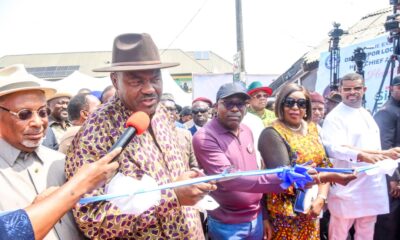Agriculture
Stakeholders List Benefits Of Moringa
Harnessing the economic potential of
the ‘Moringa Olifera’ is the focus of the discussion at the first
international conference on the crop at the University of Ilorin.
Our correspondent reports that representatives of various
organisations, including the ‘Moringa’ Association, the academia, research
institutes, colleges of agriculture and the National Agricultural Research
System (NARS) are participating in the conference.
Delivering a
lecture at the conference, Prof. Yusuf Abubakar, the Executive Secretary,
Agricultural Research Council of Nigeria (ARCN), noted that the plant had
aroused overwhelming national and international interest.
Abubakar said: “Moringa has been described as an “all in one’
plant in terms of its nutritional attributes, and elegantly summarised as a
supermarket on a tree.
“It deserves all the attention of policy makers, researchers,
farmers, products promoters, and other players across the product value chain.
“We recommend
that it should be included amongst the value chain commodities of the
Agricultural Transformation Agenda (ATA),” he said.
He said that
the conference could not have been organised at a better moment than now considering
the enormous potential of Moringa in contributing to Nigeria’s food security,
wealth creation and poverty alleviation.
According to
him, Moringa is mostly found in the northern parts of the country, where it has
been in use for many centuries by rural dwellers as a salad-like meal (kwado)
or in soups (miyan zogala) and as a pot herb, until the recent discovery of its
other benefits by researchers.
He noted that
the plant, grown in home gardens or as living fences, the leaves are commonly
sold in local markets in many forms.
He explained
that recent scientific research classified ‘Moringa’ as a very versatile plant
as everything about it was useful in one way or the other, from its leaves to
its roots.
The executive
secretary said the plant was discovered to contain specific antioxidants and
health promoting ingredients that offered veritable answers to malnutrition,
hunger and diseases.
He said that
the World Health Organisation (WHO), the European Union, UNICEF and many other
organisations and NGOs, support the planting of ‘Moringa’ in Africa and other
places with a view to fighting malnutrition and deforestation.
In his
opening address, Prof. Olawale Badejo of the University of Ilorin, said the
‘Moringa’ leaves was rich in protein, vitamins and minerals, and could be
utilised to prevent malnutrition.
Similarly,
Prof. Is’haq Oloyede, the Vice Chancellor, University of Ilorin, said the
institution had cultivated 631 hectares with cash crops, including teak, date
palm, jatropha, cashew and citrus, adding that it had recently added ‘Moringa’
species.
Agriculture
FG, Ogun Distribute Inputs To 2,400 Farmers
Federal Government and the Ogun State Government, on Wednesday, distributed farm inputs to farmers as part of effort to address food security challenge.
The State Director, Federal Ministry of Agriculture and Food Security, Dr. Toyin Ayo-Ajayi, during the flag-off ceremony of Inputs Redemption Under The National Agricultural Growth Scheme-Agro Pocket (NAGS-AP), in Ogun State, disclosed that beneficiaries of the gesture were primarily rice, maize and cassava farmers across the State.
Ayo-Ajayi commended the Ogun State Government for partnering with the government at the centre for the effort in supporting farmers with inputs that would bring about yieldings for local consumption and likely exportation.
She noted that government is supporting rice, cassava and maize farmers with inputs worth N212,000; N189,000 and N186,000 respectively.
The Permanent Secretary in the State Ministry of Agriculture, Mrs Kehinde Jokotoye, who represented the Commissioner in the Ministry, Bolu Owotomo, stated that traditional farmers are critical in food production, hence the need to encourage and support them with inputs that would bring about desired results during harvesting.
Owotomo said: “Let us make good use of this opportunity, so that the success of this phase will make farmers benefit more from the state and federal governments of Nigeria.”
Earlier, State Coordinator, Federal Ministry of Agriculture and Food Security, Dr. Oluwatoyin Ayo-Ajayi, appreciated the present administration for partnering with the federal government for the initiative, adding that the programme is designed to support farmers at the grassroots level in cassava, rice and maize with inputs such as, seeds, pesticides, herbicides and fertilizers, to boost their production and enhance their livelihood.
Agriculture
Niger Allocates 10,000 Hectares For Smallholder Farmers
The Niger State Government has mapped out 10,000 hectares of farmland in Gbapo Community of Katcha Local Government Area of the State for smallholder farmers to benefit from the state government’s agricultural intervention programme.
Two thousand out of the 10,000 holders of the farmlands have already received inputs.
At a flag-off ceremony in Yinti Village, the facilitator of the programme, Shinkafan Nupe, Malam Idris Usman Makanta, assured the farmers of increased distributions to the mapped-out ten thousand (10,000) farmlands if farmers respond positively.
He explained that the commencement of the two thousand is to measure the positive response of farmers before obtaining full-scale support.
Malam Makanta stated that this initiative aligns with the farmers’ initial commitment through Niger Foods, whose mission is primarily geared towards establishing efficient and profitable agricultural businesses to support the present administration of Governor Mohammed Umaru Bago’s quest to boost agricultural productivity in the state.
He also commended Niger Foods for their steadfastness and resilience in the effective implementation of the input financing scheme.
Makanta reiterated the commitment of the State Governor in making judicious use of the arable land in the state.
Shinkafan Nupe, therefore, urged the farmers to support the Governor by using the inputs wisely so that the dream can be actualised.
Agriculture
GO-CARES: Gombe Empowers 573,429 Farmers, Entrepreneurs
The Gombe State Government has empowered a total of 573,429 farmers and entrepreneurs under the 4th phase of the GO-CARES programme.
The programme was officially flagged off by Governor Inuwa Yahaya in another major step towards alleviating poverty and supporting the state’s vulnerable populations.
The Governor, while inaugurating the disbursement in Akko Community of Akko Local Government Area, restated his administration’s commitment to the welfare of vulnerable citizens in the state.
He was represented by the Commissioner for Budget and Economic Planning, Salihu Baba Alkali, who is also the Chairman of the Steering Committee on GO- CARES implementation.
“The 4th phase of GO-CARES will directly and indirectly impact a total of 573,429 citizens across the state. Of these, 152,429 individuals will benefit directly through cash transfers, livelihood grants, agricultural inputs, and operational grants to small businesses”, he stated.
The Governor added that, “421,000 people will be indirect beneficiaries through infrastructural projects such as classroom blocks, healthcare facilities, WASH services, and rural infrastructure projects like culverts and drainages”.
Yahaya, reaffirmed his commitment to ensuring that the state’s most vulnerable citizens are not left behind in the state’s development.
According to him, “Earlier this year, on June 25, 2024, we flagged off the distribution of improved seedlings, fertilizers, and herbicides to less privileged farmers in Malam Sidi, Kwami Local Government Area, signaling the commencement of the 4th phase implementation of GO-CARES under Result Area 2”.
The Governor reiterated that these initiatives have had a significant impact on the livelihoods of beneficiaries and the overall agricultural sector.
He explained that, “Today’s ceremony marked the simultaneous launch of activities under all three GO-CARES Result Areas for the 4th phase. These areas include: State Cash Transfer Grants: 2,500 direct beneficiaries; Labour Intensive Public Works: 2,700 direct beneficiaries; Livelihood Grants: 10,000 direct beneficiaries; and Basic Services: 405,000 indirect beneficiaries”.
-
Rivers1 day ago
PH/Owerri Road Users Express Relief Over Killing Of Kidnap Kingpin
-

 Featured1 day ago
Featured1 day agoFG urges unified efforts against emerging COVID-19 threats
-

 Business1 day ago
Business1 day agoNigeria’ll Lead In Agricultural Export This Year – Tinubu
-

 News1 day ago
News1 day agoYou’ve Shown Courage In Defence Of Rivers, Fubara Tells Sen Mbata …As He Marks 65th Birthday
-
Rivers1 day ago
Commissioner Commends Gov Over Support For Ministry
-
Rivers1 day ago
Rivers CP decorates 118 Newly promoted officers of the police Command.
-
Women1 day ago
Dealing With Issues Of Singlehood
-

 News1 day ago
News1 day agoMonarch Hails RSG for Siting COE In Opobo

